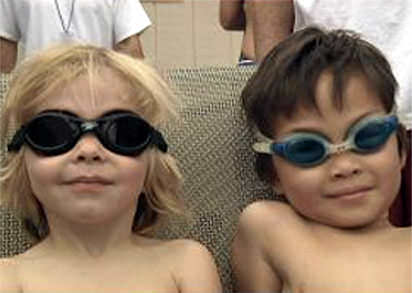Water Safety

Blue Buoy Water Safety
Water Safety Articles
Pediatricians Sign on to Swim Lessons
Swimming Safety
The Safer 3 Drowning Prevention Message:
• By using the word “safer” instead of “safe” we reinforce the idea that risk is always present when we are in, on, or around the water.
• The risk cannot be eliminated; but, it can be reduced and managed.
• There is no “one” answer to drowning prevention.
• A drowning is usually the result of a series of unfortunate events.
• Since we never know what will go wrong, a multiple strategies approach provides the best chance of preventing a tragedy.
Create A Recipe for Prevention:
• What if every family asked: “Where is our risk in this situation?”, “What can we do to reduce it?” Remember, risk is continually changing with your child’s age as well as the location and type of water you’re in, on, or around.
Safer Water
• Determine the risk associated with a particular water environment. It could be a backyard pool or spa, a community pool, open water such as a pond in a local park, lakes, rivers, ocean or even household water such as toilets or bathtubs.
• In the home, prevent access to water for a young child by placing barriers such as four-sided fencing around a pool, install a cover,place alarms at entry doors or windows, empty buckets & turn them upside down, close toilet lids, and never leave your child unattended in the bath.
• In public settings, children should swim or play in water that is supervised by lifeguards and other responsible adults. Watch for high surf and rip currents. Determine the safest areas for activity to reduce the risk.
Safer Kids
• Supervision must be active rather than passive. Don’t talk on the phone or read a book when supervising your children.
• Swim lessons can develop the skills and experience to preserve the life of the potential victim. Learning to “live in the water” is a process that takes time. Don’t ever consider your child “water safe” or believe someone can “drown proof” your child in a short period of time. Lessons should emphasize proper behavior when in, on or around the water.
Safer Response
• We should be prepared in the event that something goes wrong. Learning and maintaining CPR skills, preparing a plan of action, always having a phone present to call 911, and providing rescue equipment or procedures could be the last line of defense.
Possible Drowning Event Factors
• An unsupervised child gains access to a backyard pool or spa.
• A child without swimming ability is in a pool during a family gathering & passive supervision allows distress to go unnoticed.
• A child with swimming ability uses bad judgment, placing themselves or others in danger.
• An accident occurs & the first responder is not trained in rescue procedures.

